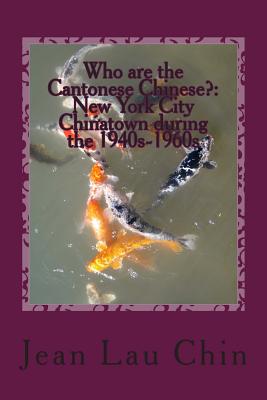Who are the Cantonese Chinese?: New York City Chinatown during the 1940s-1960s: New York City Chinatown Oral History Project (Black and White version)

Who are the Cantonese Chinese?: New York City Chinatown during the 1940s-1960s: New York City Chinatown Oral History Project (Black and White version)
The Cantonese Chinese were largely Toisanese peasant farmers from southern China and the original Chinese pioneers to the United States starting in the 1800s. Recruited as cheap labor to build the transcontinental railroad, they faced harsh discrimination and were viewed as an economic threat during the California Gold Rush. After its completion, they were omitted from the U.S. annals and the only national group ever to be barred from immigrating to the U.S. by the Chinese Exclusion Acts between 1882 and 1943. After World War II, they were then viewed as communist threats. As they migrated east to New York City, laundries and restaurants were the only occupations opened to them. They retreated to the safe havens of New York City's Chinatown or became the lone Asians in their neighborhoods in the outer boroughs. Their offspring are the voices in this book; they are the Chinese Americans growing up in New York City's Chinatown between the 1940s and 1960s, a generation sandwiched between post-World War II (1941-1945) and the Civil Rights Movement of the 1960s. What was life in New York City's Chinatown like during that time? Their stories are a psychosocial account capturing the bonds, the family and community networks, the struggles and the resiliency of growing up Chinese in New York City. Their parents came from working in the rice fields of southern China to toiling as laundry, restaurant, and garment workers in the United States. This generation went on to become upstanding citizens working in professional fields-mostly engineering and teaching. As a group, their accomplishments and achievements were unsurpassed. Because there were so few Chinese Americans outside of the laundries and restaurants, their entry into many fields were untraditional and exceptions. They often became the "first". As Ted Ho, one of our participants, said: "And we did it in one generation!" Why this book about this group of ordinary people? Lest it be forgotten, we need to document these stories-struggles and accomplishments-of the early Chinese pioneers to the U.S. for the next generations. They grew up in a society intolerant of their differences-they were viewed as the perpetual foreigner and scapegoated by earlier immigrant groups. While the Toisanese were once the majority of the U.S. Chinese American population, they have been increasingly replaced by the Cantonese and Taiwanese in the 60s and 70s, by the Vietnamese Chinese in the 80s, and by "mainland Chinese" largely
PRP: 93.00 Lei
Acesta este Pretul Recomandat de Producator. Pretul de vanzare al produsului este afisat mai jos.
83.70Lei
83.70Lei
93.00 LeiLivrare in 2-4 saptamani
Descrierea produsului
The Cantonese Chinese were largely Toisanese peasant farmers from southern China and the original Chinese pioneers to the United States starting in the 1800s. Recruited as cheap labor to build the transcontinental railroad, they faced harsh discrimination and were viewed as an economic threat during the California Gold Rush. After its completion, they were omitted from the U.S. annals and the only national group ever to be barred from immigrating to the U.S. by the Chinese Exclusion Acts between 1882 and 1943. After World War II, they were then viewed as communist threats. As they migrated east to New York City, laundries and restaurants were the only occupations opened to them. They retreated to the safe havens of New York City's Chinatown or became the lone Asians in their neighborhoods in the outer boroughs. Their offspring are the voices in this book; they are the Chinese Americans growing up in New York City's Chinatown between the 1940s and 1960s, a generation sandwiched between post-World War II (1941-1945) and the Civil Rights Movement of the 1960s. What was life in New York City's Chinatown like during that time? Their stories are a psychosocial account capturing the bonds, the family and community networks, the struggles and the resiliency of growing up Chinese in New York City. Their parents came from working in the rice fields of southern China to toiling as laundry, restaurant, and garment workers in the United States. This generation went on to become upstanding citizens working in professional fields-mostly engineering and teaching. As a group, their accomplishments and achievements were unsurpassed. Because there were so few Chinese Americans outside of the laundries and restaurants, their entry into many fields were untraditional and exceptions. They often became the "first". As Ted Ho, one of our participants, said: "And we did it in one generation!" Why this book about this group of ordinary people? Lest it be forgotten, we need to document these stories-struggles and accomplishments-of the early Chinese pioneers to the U.S. for the next generations. They grew up in a society intolerant of their differences-they were viewed as the perpetual foreigner and scapegoated by earlier immigrant groups. While the Toisanese were once the majority of the U.S. Chinese American population, they have been increasingly replaced by the Cantonese and Taiwanese in the 60s and 70s, by the Vietnamese Chinese in the 80s, and by "mainland Chinese" largely
Detaliile produsului








